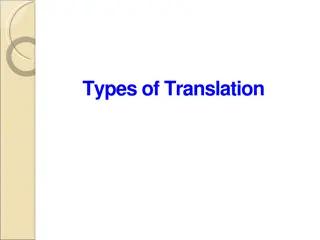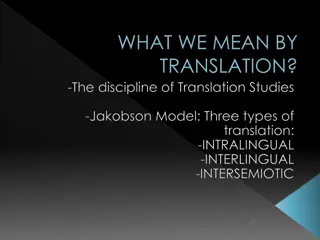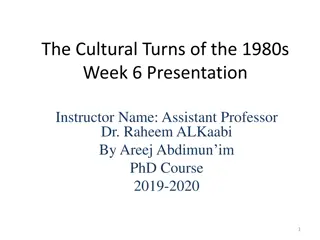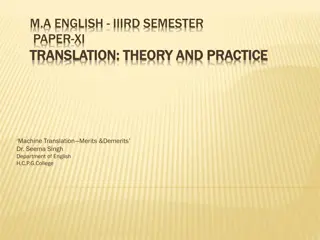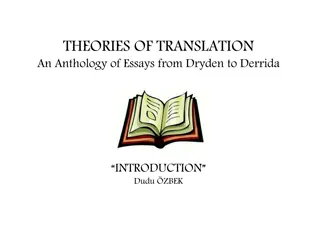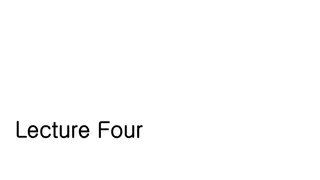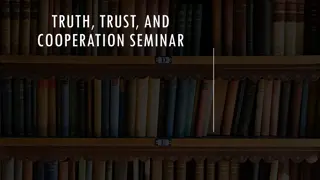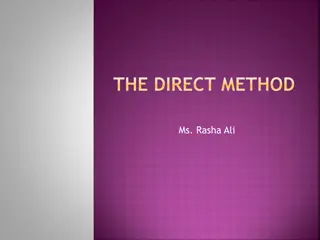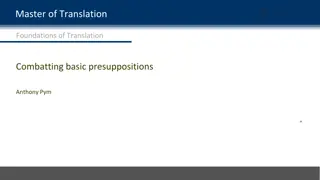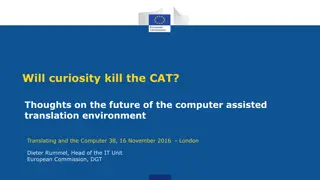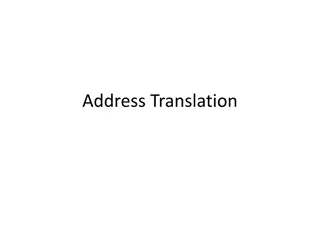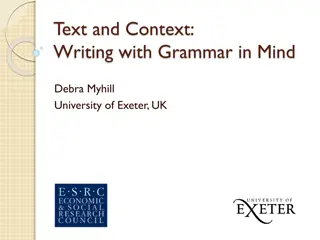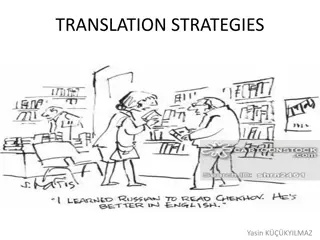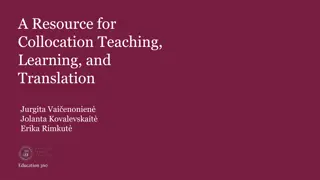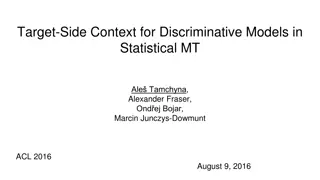Evolution of Language Teaching Methods: From Grammar Translation to Direct Method
Explore the historical development of language teaching methods, starting from the traditional Grammar Translation Method to the innovative Direct Method alongside key figures and principles. The transition from text-focused, deductive grammar teaching to conversational, inductive approaches marks a significant shift towards immersive language learning experiences.
Download Presentation

Please find below an Image/Link to download the presentation.
The content on the website is provided AS IS for your information and personal use only. It may not be sold, licensed, or shared on other websites without obtaining consent from the author. Download presentation by click this link. If you encounter any issues during the download, it is possible that the publisher has removed the file from their server.
E N D
Presentation Transcript
Approaches and Methods in Language Teaching Jack C. Richards & Theodore S. Rodgers V.Peruvalluthi, Ph.D. Professor Department of English Thiruvalluvar University Vellore valluthi@gmail.com
Traditional Method The Grammar Translation Method Johann Sedenstuker Karl Plotz H.S.Ollendorf Johann Meidinger It was known as the Prussian Method in The USA
Principle Characteristics of Grammar Translation Method Goal of foreign language study is to read its literature Reading & writing major focus; speaking & listening generally ignored
Vocabulary based on reading text Sentence is the basic unit of teaching & learning practice
Accuracy emphasized Grammar taught deductively (usually the terminology used for studying Latin Grammar) Student s native language medium of instruction
The Reform Movement (Based on Applied Linguistics) Beginning of a scientific approach In 1880s: Linguists Henry Sweet (England); Wilhelm Vietor (Germany); & Paul Passy (France) In 1886 the International Phonetic Association formed & its International Phonetic Alphabet (IPA) designed
It advocated: The study of spoken language Phonetic training Use of conversation texts Inductive approach for teaching grammar Focus only on target language (mother tongue avoided)
Direct Method Parallel to the Reform Movement A natural method based on naturalistic principles in language learning In 1860 L. Sauver s Boston language school: Natural Method Maxmilian Berlitz s Berlitz Method : Natural Method
Berlitz Method (Theory) Classroom instruction in target language Everyday vocabulary & sentences taught Graded oral communication for small classes Inductive grammar teaching New teaching points introduced orally Concrete vocabulary: demonstration Abstract vocabulary: association of ideas Speech & Comprehension taught Correct pronunciation & grammar emphasized
Berlitz School Guidelines (Strategy) Never translate: demonstrate Never explain: act Never make a speech: ask questions Never imitate mistakes: correct Never speak with single words: use sentences Never speak too much: make students speak much
Never use the book: use your lesson plan Never jump around: follow your plan Never go too fast: keep the pace of the student Never speak too slowly: speak normally Never speak too quickly: speak normally Never speak too loudly: speak naturally Never be impatient: take it easy Limitation of the method: Teacher should be very competent
Major Trends in 20thCentury Language Teaching Language teaching became professional in the 20thcentury.
Drew form Linguistics & Psychology To develop principles & procedures for the design of teaching methods & materials The method concept in teaching: teaching practices based on particular theory of language & language learning was adopted
Language Teaching Approaches & Methods : Assumptions An approach or method refers to a theoretically consistent set of teaching procedures that define best practice in language teaching
Particular approaches and methods, if followed precisely, will lead to more effective levels of language learning than alternative ways of teaching The quality of language teaching will improve if teachers use the best available approaches and methods
Why Study ELT Approaches & Methods? The study of approaches and methods provides teachers with a view of how the field of language teaching has evolved
Approaches & methods can be studied not as prescriptions for how to teach but as a source of well-used practices, which teachers can adapt or implement based on their own needs
Experience in using different teaching approaches and methods can provide teachers with basic teaching skills that they can later add to or supplement as they develop teaching experience
Approach, Method & Technique (Edward Anthony, 1963) An approach is a set of correlative assumptions dealing with the nature of language teaching & learning. It is axiomatic.
Method is an overall plan for the orderly presentation of language material based upon the selected approach. It is procedural.
A technique is implementationalthat which actually takes place in a classroom. Techniques must be consistent with a method, and therefore in harmony with an approach as well.
Approach is the level at which assumptions and beliefs about language and language learning are specified Method is the level at which theory is put into practice and at which choices are made about the particular skills to be taught, the content to be taught and the order in which the content will be presented Technique is the level at which classroom procedures are described
Format of Approach & Methods (A) Approach (assumptions) Theory of language Theory of language learning
(B) Design Objectives Content choice and organization: The syllabus Types of learning & teaching activities Learner roles Teacher roles The role of instructional materials
Role of instructional material The primary goal of material: To present content To practice content To facilitate communication between learners To enable learners to practice content without the teacher s help
The form of materials: Textbook Audiovisuals Computer software
The relation of materials to other sources of input Whether they serve as the major source of input or only as a minor component of it
The abilities of teachers Their competence in the language or degree of training & experience
(C) Procedure Three dimensions of a method: (a) the use of teaching activities (drills, dialogues, information-gap activities, etc.) to present new language and to clarify and demonstrate formal, communicative, or other aspects of target language
(b) the ways in which particular teaching activities are used for practicing language (c) the procedures & techniques used in giving feedback to learners concerning the form or content of their utterances or sentences
Communicative Language Teaching (CLT) Theory of language Language as communication Linguistic theory must incorporate communication & culture (Hymes in contrast to Chomsky s theory on competence) Competences: Grammatical; Sociolinguistic; Discourse; & Strategic (Henry Widdowson)
Theory of Learning 1. Communication principle: Activities that involve real communication promote learning 2. Task principle: Activities in which language is used for carrying out meaningful tasks promote learning
3. Meaningfulness principle: Language that is meaningful to the learner supports the learning process Note: Language activities are consequently selected according to how well they engage the learner in meaningful & authentic language use (rather than merely mechanical practice of language pattern)
The cognitive aspect [of learning] involves the internalisation of plans for creating appropriate behaviour. (From grammatical rules; vocabulary; & social conventions governing speech) The behavioural aspect [of learning] involves the automation of these plans to be converted into fluent performance in real time. This occurs mainly through practice in converting plans into performance
Design Objectives To reflect specific aspects of communicative competence according to the learner s proficiency level & communicative needs
The Syllabus A purely procedural syllabus which lists, in more or less detail, the types of tasks to be attempted in the classroom and suggests an order of complexity for tasks of the same kind
Types of learning & teaching activities Functional communication activities (comparing, sequencing, discovering, solving problems from shared clues) Social interaction activities (conversation/discussion sessions; dialogues/role plays; simulations; skits; improvisations & debates)
Learner roles Should acknowledge cooperative approach; successful communication is an accomplishment jointly achieved & acknowledged
Teacher roles Facilitator Organizer Guide Researcher Needs analyst Counselor Group process manager
The role of instructional materials Text-based materials: theme, task oriented thematic development, practice situation, stimulus presentation, comprehension & paraphrase Task-based materials: games, role plays, simulations Realia : signs, magazines, advertisements, newspapers, maps, pictures, symbols, graphs & charts
Procedure Presentation of brief dialogue Oral practice of the dialogue Questions & answers on the dialogue Question & answer on related personal experiences Study of one communicative structure Learner discovery of rules Oral production Written homework assignment Evaluation: oral
The Oral Approach & Situational Language Teaching
Developed by British applied linguists from 1930s to 1960s. Harold Palmer, A.S. Hornby & West They attempted to develop a more scientific method for an oral approach to teaching English Vocabulary control: a) vocabulary was an important aspect in learning a foreign language b) increased emphasis on reading skills as the goal of foreign language study
Grammar control: Palmer viewed grammar as the underlying sentence patterns of the spoken language substitution tables were evolved by the linguists which could be used to help internalize the rules of English sentence structure
They developed an approach to methodology that involved systematic principles of Selection: The procedures by which lexical & grammatical content was chosen Gradation: Principles by which the organization & sequencing of content were determined Presentation: Techniques used for presentation & practice of items in a course
In 1960s Australian George Pittman and his colleagues, especially, Gloria Tate were responsible for developing an influential set of teaching materials based on the Situational Approach
Approach Theory of Language: A type of British structuralism different from American structuralism the notion of situation ; Pittman declared: Our principal classroom activity in the teaching of English structure will be the oral practice of structures. This oral practice of controlled sentence patterns should be given in situations designed to give the greatest amount of practice in English speech to the pupil.
Theory of Learning: (Process oriented) It adopts an inductive approach to the teaching of grammar. The meanings of words or structures is not to be given through explanation in either the native language or the target language but is to be induced from the way the form is used in a situation. The learner is then expected to apply the language learned in the classroom to situations outside the classroom.
Design Objectives: To teach a practical command of the four basic skills of language taught through structure. Accuracy in both pronunciation and grammar is regarded as crucial, and errors are to be avoided at all costs.
The Syllabus: Uses a structural syllabus & word list. A structural syllabus is a list of the basic structures & sentence patterns of English, arranged according to their presentation. Eg. :This is /That is book/pencil/ruler/desk. Note: Situation refers to the manner of presenting & practicing sentence patterns






